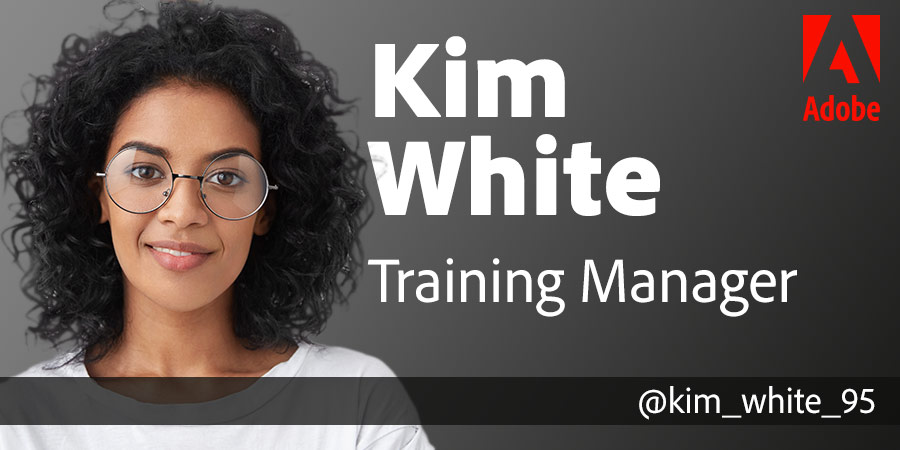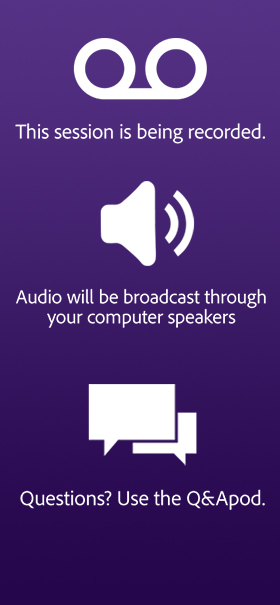Images are an incredibly powerful way to present information or add visual interest to a web page. They were part of the original HTML specification and it’s difficult to find a web page on the internet today that doesn’t include an image.
We often see virtual rooms that include little to no imagery though, and that’s too bad because creating and using images is an easy but effective way to create rooms that look great and visually engage the participants. This is especially true in Adobe Connect, where you can upload an image (JPG, PNG, and now GIF) to a share pod in the same way you can load a PowerPoint deck or PDF document.
In this post, we will outline some of the strategies I discussed both for using Photoshop and Adobe Connect.

Photoshop Presets
When you create a new document in Photoshop, you’re presented with a dialog enabling you to select a preset. For example, an A4-sized paper or HDTV-sized screen. These presets include, among other things, the width, height, and resolution of your new image.
You can also create your own Photoshop presets, and I’ve found this to be extremely helpful. There’s no need to remember that a Large Event Banner in Adobe Connect Events in 740×300 and a Small Event Banner is 560×230. I can simply create presets for each of these and let Photoshop take care of creating a document that is the perfect size.
We use Photoshop presets for room backgrounds, name cards, event banners, and more and I recommend them as an easy way to get started.
Room Backgrounds

Most new Adobe Connect rooms have a light gray background. It’s subtle and neutral by design and it can certainly help put the focus on your content. However, I believe adding a custom room background is the easiest way to add some visual interest to your room. It also customizes it and sets it apart from other rooms.
Adobe Connect will automatically size your background for all participants. It will never disproportionally stretch your image – so it’s safe to add logos or other photorealistic content. There’s no specific size required since it will be sized automatically, so I use 1,920 x 1,200 – which is a nice balance for quality and file size.
Your background will typically be covered with pods, so I’d recommend not making it too ‘busy’. Something abstract tends to work well. You can add your logo to one of the corners and size the pods in your room appropriately.
In the webinar recording, I describe how you can use Photoshop’s Vanishing Point feature to place text on a surface in your image, and the Smart Objects feature of Photoshop to create a white monochrome version of a multi-colored logo. These are useful tips for many images you may deal with.
Once you’ve created your document, you can import a stock image as a starting point by using the ‘Place Embedded…’ command or create something from scratch. When finished, use the Export command to save out a JPG. Adjust the quality sliders so that your image isn’t too big – remember that everyone will have to download it. I aim for 300k or less.
Apply the background in Adobe Connect using the Meeting menu. If you added your logo to your image, you could choose to ‘pin’ the image in Adobe Connect to a specific corner. This will ensure your logo never gets cut off as the image is resized for different monitors.
Virtual Name Cards
Webcam video can be great. But being on video constantly isn’t something everyone wants – and it’s certainly not something that should be required. A great alternative is to use a virtual name card. Rather than just your headshot, this is an opportunity to provide additional information – like your name, title, and Twitter handle.

Photoshop has an option to automatically select the subject of an image and create a selection. This was recently improved with Adobe Sensei and machine learning and does a great job with even difficult selections. It’s an ideal feature for placing your headshot on a canvas, and removing the background automatically.
Once finished, simply save it as a JPEG file, and drag it onto a blank share pod in Adobe Connect.
Event Imagery
Example of a Large/Small banner image for your Adobe Connect events.
The Events module in Adobe Connect can help you promote your live and on-demand events with a gorgeous microsite that includes information about your event and speaker as well as registering users. It will also handle email invitations and follow-ups with rich HTML-formatted emails.
Setting up an event requires a few images. A Large Banner Image for the microsite, a Small Banner Image for the emails, and an Event Logo for the catalog. Again, Photoshop can help us create these quickly using presets.
Adding whitespace to your event banners can be a challenge – but necessary since you likely need to include the name and date of the event as part of the image. In the webinar recording, I show you how Photoshop’s Content-Aware Scale tool can be used to stretch an image without negatively impacting the subject. It’s an ideal tool for adding extra space in your images.
Your Small Event Banner will likely be a near duplicate of your Large Event Banner. While you probably know that you can duplicate layers in Photoshop, you may not have realized that layers can be duplicated into other documents. Duplicating a layer from your Large Event Banner to your Small Event Banner makes creating a second image fast and easy.
Room Information
Many of your virtual sessions will kick off with some housekeeping notes and introductions. A host or facilitator may want to let everyone know the session is being recorded and provide instructions on how they can ask questions and interact.
While this information can certainly be relayed verbally, it’s a good idea to also include a visual aid. A PowerPoint slide would work, but an image will load more quickly and it’s easier to create and size perfectly with Photoshop.

For this image, the Creative Cloud Libraries feature comes in very handy. You can store common elements such as images, colors, text, and more in your Cloud Library and access them across any of the Creative Cloud applications – including Adobe Photoshop.
In this case, we can leverage the Creative Cloud Library for elements we want to include in our housekeeping section, such as a speaker icon, chat icon, and recording icon.
We can simply drag and drop these elements onto our canvas in Photoshop to create a custom image we can use for our session.
 sv
sv  no
no fi
fi en
en da
da













